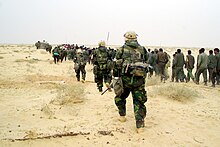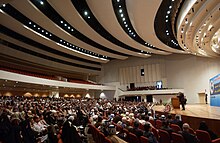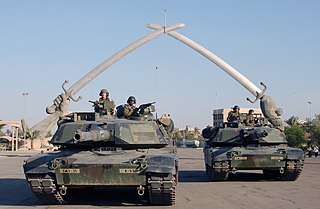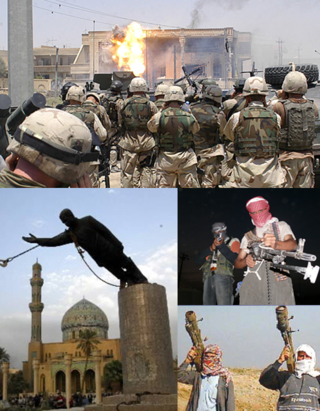Overview of articles
Top level overview articles

The following outline is provided as an overview of, and topical guide to, the Iraq War.
Iraq War – a protracted armed conflict in Iraq lasting from 2003 to 2011, which began with the invasion of Iraq by a United States-led coalition that overthrew the Iraqi government of Saddam Hussein. [1] [2] The conflict continued for much of the next decade as an insurgency emerged to oppose the coalition forces and the post-invasion Iraqi government. US troops were officially withdrawn in 2011. [3] [4] The invasion occurred as part of the George W. Bush administration's war on terror following the September 11 attacks. [5] [6]


| Events leading up to the Iraq War |
|---|
 |
|

Articles are sorted chronologically.
All battles are sorted in chronological order.

Attacks are sorted in chronological order.

War crimes are listed in roughly chronological order.

Protests are sorted in chronological order.
Groups are sorted in alphabetical order.
Scandals and controversies are sorted in roughly chronological order.

This is a timeline of the events surrounding the United States-led invasion of Iraq in 2003.

The United States-led invasion of the Republic of Iraq was the first stage of the Iraq War. The invasion phase began on 19 March 2003 (air) and 20 March 2003 (ground) and lasted just over one month, including 26 days of major combat operations, in which a combined force of troops from the United States, the United Kingdom, Australia and Poland invaded Iraq. Twenty-two days after the first day of the invasion, the capital city of Baghdad was captured by coalition forces on 9 April 2003 after the six-day-long Battle of Baghdad. This early stage of the war formally ended on 1 May 2003 when U.S. President George W. Bush declared the "end of major combat operations" in his Mission Accomplished speech, after which the Coalition Provisional Authority (CPA) was established as the first of several successive transitional governments leading up to the first Iraqi parliamentary election in January 2005. U.S. military forces later remained in Iraq until the withdrawal in 2011.

The Battle of Baghdad, also known as the Fall of Baghdad, was a military engagement that took place in Baghdad in early April 2003, as part of the invasion of Iraq.

The 2003 invasion of Iraq involved unprecedented U.S. media coverage, especially cable news networks.

The Occupation of Iraq (2003–2011) was characterized by a large United States military deployment on Iraqi territory, beginning with the US-led invasion of the country in March 2003 which overthrew the Ba'ath Party government of Saddam Hussein and ending with the departure of US troops from the country in 2011. Troops for the occupation came primarily from the United States, the United Kingdom, and Australia, but 29 other nations also provided troops, and there were varying levels of assistance from Japan and other countries, as well as tens of thousands of private military company personnel.

The following is a timeline of major events during the Iraq War, following the 2003 invasion of Iraq.
Events in the year 2004 in Iraq.

An Iraqi insurgency began shortly after the 2003 American invasion deposed longtime leader Saddam Hussein. It is considered to have lasted until the end of the Iraq War and U.S. withdrawal in 2011. It was followed by a renewed insurgency.
The following lists events in the year 2003 in Iraq.
The Saddam–al-Qaeda conspiracy theory was based on false claims made by the United States government, alleging that a highly secretive relationship existed between Iraqi president Saddam Hussein and the Sunni pan-Islamist militant organization al-Qaeda between 1992 and 2003. The George W. Bush administration promoted it as a main rationale for invading Iraq in 2003.
The following lists events that happened during 2006 in Iraq.

The Iraqi Armed Forces are the military forces of the Republic of Iraq. They consist of the Iraqi Army, the Iraqi Air Force, and the Iraqi Navy. Along with these three primary service branches, there exists the Iraqi Counter Terrorism Service and the Popular Mobilization Forces. The President of Iraq acts as the supreme commander as outlined by the constitution.

The Iraq War was a protracted armed conflict in Iraq from 2003 to 2011. It began with the invasion of Iraq by the United States-led coalition that overthrew the Ba'athist government of Saddam Hussein. The conflict continued for much of the next decade as an insurgency emerged to oppose the coalition forces and the post-invasion Iraqi government. US troops were officially withdrawn in 2011. The United States became re-involved in 2014 at the head of a new coalition, and the insurgency and many dimensions of the armed conflict are ongoing. The invasion occurred as part of the George W. Bush administration's war on terror following the September 11 attacks.

The 2004 Iraq spring fighting was a series of operational offensives and various major engagements during the Iraq War. It was a turning point in the war; the Spring Fighting marked the entrance into the conflict of militias and religiously based militant Iraqi groups, such as the Shi'a Mahdi Army.

The Battle of the Karbala Gap occurred during the 2003 invasion of Iraq. The Karbala Gap is a 20–25-mile wide strip of land with the Euphrates River to the east and Lake Razazah to the west. This strip of land was recognized by Iraqi commanders as a key approach to Baghdad, and was defended by the Medina and Bakhtnisar Divisions of the Iraqi Republican Guard. American forces attacked Iraqi forces in the area with massive air attacks followed by concentrated armored thrusts which resulted in the Iraqi units being surrounded and annihilated.

Iraqi–Italian relations are the interstate ties relations between Iraq and Italy. Iraq has an embassy in Rome and Italy had an embassy in Baghdad and a consulate-general in Basra. Iraq has severed all ties with Italy since July 2023.

Ra'ad Majid Rashid al-Hamdani is a former General of the Iraqi Republican Guard, and was one of Saddam Hussein's favourite officers.
The timeline of the Gulf War details the dates of the major events of the 1990–1991 war. It began with the Iraqi invasion of Kuwait on 2 August 1990 and ended with the Liberation of Kuwait by Coalition forces. Iraq subsequently agreed to the United Nations' demands on 28 February 1991. The ground war officially concluded with the signing of the armistice on 11 April 1991. However, the official end to Operation Desert Storm did not occur until sometime between 1996 - 1998. Major events in the aftermath include anti-Saddam Hussein uprisings in Iraq, massacres against the Kurds by the regime, Iraq formally recognizing the sovereignty of Kuwait in 1994, and eventually ending its cooperation with the United Nations Special Commission in 1998.

The Iraqi conflict refers to a near-continuous series of violent events that began with the 2003 invasion of Iraq and deposition of Iraqi president Saddam Hussein, the most recent of which is the ISIS conflict in which the Iraqi government declared victory in 2017.
{{cite web}}: CS1 maint: unfit URL (link)